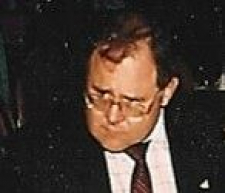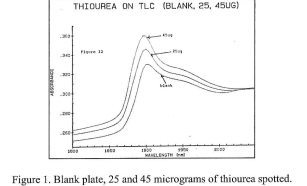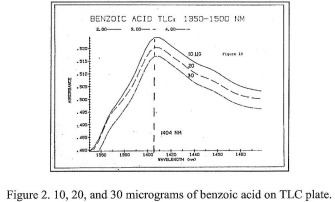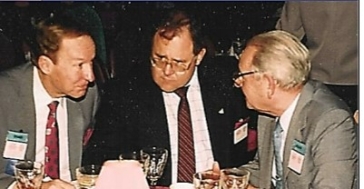Memories of Karl
Contribution from Emil Ciuczak

My first introduction to Karl wasn’t a formal meeting; it was more of a “teaching moment.” I was in the second year of “playing with” NIR (1984) and was presenting some results at the Technicon meeting. They were nice enough to make my slides, so I hadn’t seen them prior to the meeting. My first-time meeting Karl at IDRC 2010 with Phil Calvi. So, I hastily went through them and placed them in some order in the slide carousel, immediately before I was to present them.
My project was performing thin layer chromatography, using NIR as the detection method. I was “inspired” to see how small an amount of analyte could be seen, since the Technicon salesman insisted that one could not detect/analyze less than 0.1%. I wanted to see if I could detect and quantify microgram amounts. Using benzoic acid and thiourea in amounts from 10 to 45 micrograms on silica TLC plates (Figures 1 and 2), I showed that, indeed, one can see that level of analyte.


However, in my enthusiasm to show that “something happened,” I overlooked a few basics. I pointed to the slide (Figure 2) and showed that the peak differed, corresponding to the amount spotted. In my haste to move along, I simply stated, “The peak seems to diminish as the analyte increases, but I’m not sure why.” [Remember, I had only been doing NIR for about one year, at that point.] At that point, a distinguished-looking gentleman stood and said, “That’s the water peak. Your analyte is covering it up.” While I was nonplussed at the time, looking back, I am grateful that Karl stopped there… Had I been he, I might have added, “stupid!” However, he was as gracious as he was intelligent.
I actually didn’t “meet” him until several years later (1987 or 88) at an AACC meeting in St. Louis, MO (in muggy July) when I was consulting for Technicon. He was presenting for Pacific-Scientific in a joint two-vendor exhibition with us (in the same room). I was too engaged in listening to his presentation to notice the condition of the Technicon instrument (that I was to demonstrate) as it was delivered. The staff at Technicon did not send it in the proper container, but simply a cardboard box, filled with polystyrene “peanuts.” As you would imagine, the box fell apart as it was placed on the table, spilling the packing materials on the floor. Adding to my woes was the fact that the instrument was missing a leg (which I replaced with a soda bottle cap), was equipped with a fiber optic probe (with which I had never worked), and was being run by a new model computer (that I had never used) with some updated software (of which I didn’t recognize some functions). Just as I realized that they didn’t pack the sample cups, Karl walked up and introduced himself (mercifully, he either forgot my faux pas of a few years earlier or was just being polite and didn’t mention it). He was carrying a number of small plastic bags filled with white powder. After I showed him the instrument (allowing time for warming), He asked if I could measure the “hardness of wheat.” While my mind said, “What the heck is ‘hardness of wheat’?”, my mouth said, “Of course.” As Karl asked for the sample cup (which I didn’t have), he spurred me to my first methodology “discovery.” I looked him in the eyes and calmly said, “We don’t need the cups, we can use the fiber probe (reflection-type) and read directly through the bags.” Somewhere in the back of my mind, I was thinking how I just lied to the King of NIR without blinking. To make a long story short, it worked and I’ve been working through plastic since.
I was always grateful that, at almost any meeting where I presented, I could depend on Karl be sitting near the front of the room and waiting to ask the best question of the group. I used to tease him (and, rest assured he laughed with me) by saying things like, “I see Karl out there; a man I consider in the twilight of a mediocre career.” He always told me after the session that he enjoyed my wit. One time, after being lectured by the wife of another researcher that I needed to be more professional, I presented a paper without humor or cartoons. After which, Karl came up to me and said, “Good results, but it was the most boring talk you ever gave… and, you didn’t mention my name once.” Of course, I was never serious again.
Years later (1998), I was fortunate enough to have Karl work on matching two NIRSystems units for my work in pharmaceutical tablet transmission analysis. The two were so well-matched, I never needed a bias or skew adjustment AND, the spectra generated were interesting enough (and novel enough) for Karl to use them in his talks for years to come, always squeezing out one more iota of information, each time. I beamed every time he pointed out that the spectra were generated by Gary Ritchie and me.

Karl always had time to sit with me and answer questions (some of which I hadn’t even asked) as in Figure 3. with Fred McClure and me.
But my proudest (if not somewhat sad) moment came when I was tasked with putting together a session at Chambersburg, a few meetings ago. Since it was after the Sunday dinner, meaning a combination of full bellies, wine, and travel weariness, it needed some “pizzazz.” I filled it with old-timers and named the session, “What we did before the Internet.” Of course, Karl was at the top of the list, as well as Lois Weyer, Howard Mark, and Phil Williams. When I contacted Karl, he asked if I could put his slides together from some loose pictures, because his memory wasn’t as good as it used to be. I obviously accepted the honor (although he considered it a task for me) and set about doing my best. Later, after I sent him a copy, he asked if I would mind actually presenting the slides in his place. I chewed over the answer for 10-15 microseconds and accepted the “chore.”
As I gave the talk, I considered how far I had come in the science of NIRS. After stumbling into the technology in 1983 (we needed a fast way to qualify raw materials at Sandoz), giving a so-so presentation and being verbally “spanked” by Karl for a rookie error, actually performing some reasonable work, being honored by Don Burns as co-editor of his Handbook of NIR, having the great Karl Norris use some of my data for his work, and eventually actually presenting his accomplishments, using his pictures and data, in a slot that was designed for him, I finally felt that I had finally arrived into the “fraternity” of NIR users.
I have nothing but admiration and love for Karl and miss him personally as well as professionally. I am most pleased that he got to see the third edition of the Handbook dedicated to him. Rest in peace, Sensei.




